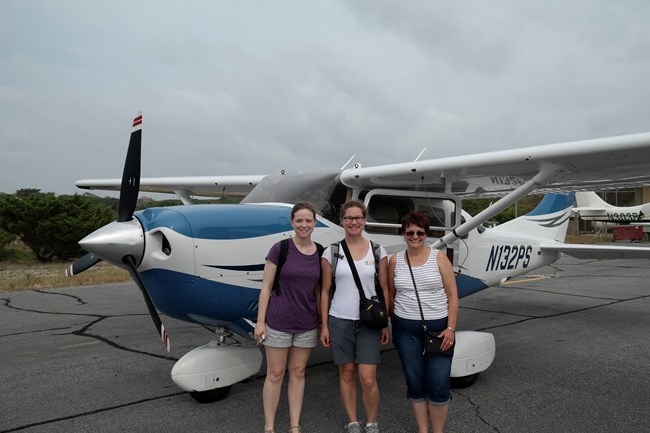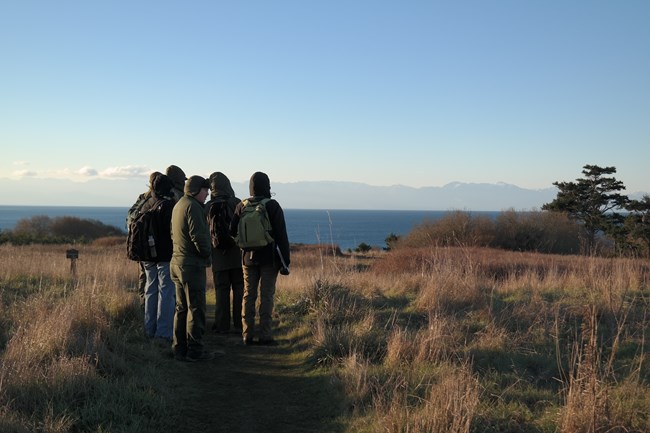Last updated: July 28, 2025
Article
Podcast 069: Bringing Cultural Landscapes into the 21st Century

National Park Service
Olmsted Center for Landscape Preservation
Maggie O’Neill: Hi, I’m Maggie O’Neill. I work in Historic Landscapes at NCPTT and today we’re sitting down with Stephanie and Leah at the Olmsted Center for Landscape Preservation. I was hoping you both could introduce yourself to begin, and what your role is at OCLP.
Stephanie Nelson: Well Maggie, my name is Stephanie Nelson and I am the Asset Preservation Coordinator for the National Park Service’s Washington Support Office Park Cultural Landscapes program. Leah and I actually work for Washington D.C. and the main headquarters for the National Park Service, but the Olmsted Center is kind enough to host us here and let us work out of their offices.
Leah Edwards: I am Leah Edwards, and my formal title is Asset Preservation Associate but technically I am a SCA working with Stephanie on the nationally significant cultural landscape inventories in FMSS (Facility Management Software System).

National Park Service
Student Conservation Association (SCA)
Maggie O’Neill: Can you clarify what SCA is?
Leah Edwards: SCA is the Student Conservation Association and it’s a national nonprofit organization that works to get people into conservation throughout. Whether its in the Park Service or any other nonprofits or anything like that.
Maggie O’Neill: So both of you work with cultural landscapes – I was hoping you both could talk about the role the Olmsted Center and you both play in relation to cultural landscapes and what your job is here.
Stephanie Nelson: Sure! Well, the Olmsted Center for Landscape Preservation started at Olmsted National Historic Site. It was a bunch of staff members who started to think about and act on how you make a landscape look and feel historic. Out of that, it has evolved to a center for landscape preservation planning, maintenance, and education. The Olmsted Center really is the Cultural Landscapes program of the Northeast Region of the National Park Service.
Maggie O’Neill: Your projects – they are part of the National Park Service as a whole – what specifically are you guys doing with them?
NPS Cultural Landscapes Inventory Project and FMSS
Leah Edwards: Our project is looking at all national parks, as a nationwide view. We look at all the cultural landscapes in all of the parks and their features. We can inventory them, in some cases, and we work to try and get them into the facility management database – FMSS, which is the database that the National Park Service uses to maintain all their facilities and organize them all.
Leah Edwards: So whenever the times comes to get work orders or any funding needed for any projects in the park, they can use that organization and this database to work on the process. Our job is to basically include all cultural landscapes features out of 390 cultural landscape units and 190 parks.

National Park Service
Stephanie Nelson: 179.
Leah Edwards: 179 Parks throughout the entire country.
Maggie O’Neill: So even though you guys are located in Boston at OCLP, you work with all regions of the Park Service?
Leah Edwards: Correct.
Scope: 179 Parks across 7 NPS Regions
Stephanie Nelson: Yes – I’ve been fortunate enough to work with all seven regions of the National Park Service. I got to go to Alaska to work with their regional cultural staff and do a site visit at Sitka National Historical Park.
Stephanie Nelson: I was also able to work in the Pacific West Region at San Juan Island National Historic Site; in the Inter-mountain Region at San Antonio Missions National Historical Park.
Stephanie Nelson: In the Midwest Region I’ve been to Keweenaw National Historical Park in the upper peninsula of Michigan, and Homestead National Monument of America in Nebraska.
Stephanie Nelson: Let’s see- in the Southeast Region, we’ve been to Cape Hatteras National Seashore, and Wright Brothers National Memorial and Fort Raleigh National Historic Site, and Stone’s River National Battlefield in Tennessee.
Stephanie Nelson: And then we’ve been in the National Capital Region, which is Washington DC, Maryland, and Virginia, at the National Mall and Memorial Parks, Washington Monument and Thomas Jefferson Memorial.
Stephanie Nelson: And in the Northeast Region, specifically we’ve worked at Fredericksburg and Spotsylvania National Military Parks and at Hopewell Furnace National Historic Site.

National Park Service
Translating Landscape Preservation into Facilities Maintenance Language
Stephanie Nelson: My favorite part of the project is putting research into action. What we do, really, is we take that research that has been written about a landscape, and what’s important in it, and translate that into facilities language.
Stephanie Nelson: So all these reports exist that are great and have a lot of information about the landscape, but that information has not been efficiently communicated to facilities [staff]. And we rely on the facilities staff to maintain our cultural landscapes. So I kind of look at it is if we don’t have our cultural landscape information in the facilities system, you can’t track it and you can’t work on it.
Maggie O’Neill: There is a huge disconnect there.
Stephanie Nelson: Huge disconnect! And we are all one National Park Service; we are all tasked with preserving our resources – cultural, natural, and visitor services. I really like being the translator between the different services.
Cultural Landscapes and Preservation Awareness
Maggie O’Neill: The relationship of cultural landscapes to the National Park Service is something that is continually worked on and it’s great to see it going in a positive direction; towards a better preservation maintenance mentality overall.
Stephanie Nelson: Exactly, it’s really exciting.
Maggie O’Neill: One of the most interesting parts about the three of us being here today is that all three of us have interned at NCPTT. Leah, you were there in 2014, and you [Stephanie] were there in 2010. I was hoping you both could talk about the projects you worked on or what you learned at NCPTT that you’re apply to the project you do now.

National Park Service
Leah Edwards: Yeah, so I was there in the summer of 2014 and I got to work on a project with Carrie Goetcheus from the University of Georgia. The project was creating a chronological timeline of literature, mostly, of cultural landscapes from its beginning conception in the National Park Service around the 1970s.
Leah Edwards: We gathered all this literature and researched that and organized it into a single spread sheet or database that could be easily searchable, so that later when Carrie continued this project she could easily search those topics and those authors and who was talking about what at during what year.
Leah Edwards: Kind of just organizing all of that information. It was a very general project but it was something that helped me – I came out of school not knowing a lot about cultural landscapes but knew I wanted to get into them. It was a good learning project to learn about the field as a whole and to delve into it later on in my career. So that’s what I did for three months.
Landscape Preservation Maintenance Video
Stephanie Nelson: I worked for the Historic Landscapes program at NCPTT. One of my tasks was to create a landscape preservation maintenance video. I also worked through the summer and beyond on various landscape preservation maintenance tasks. A video came out of it Preservation Maintenance of Turf Using Resource Sensitive Techniques in Historic Landscapes, available on the NCPTT website.
Landscape Preservation Maintenance Curriculum Expertise
Stephanie Nelson: And I got a chance, with that, to work with Debbie Smith and Charlie Pepper, here at the Olmsted Center, on the landscape preservation maintenance curriculum for field workers. So we put together a workshop on the topoic and a group meeting led me to meet Charlie Pepper.
Stephanie Nelson: Charlie had an internship available at the Olmsted Center, so I came to work with him on the landscape preservation maintenance curriculum.
Stephanie Nelson: After I left NCPTT and came up here to Boston, I worked in education and preservation maintenance. I’ve gotten to meet different people in the cultural landscapes program across the country while working with Charlie and Celena Illuzzi, the education specialist here at the Olmsted Center – working with youth programs, and working with field worker programs.
Stephanie Nelson: I had the opportunity to move into this landscapes FMSS role, working with Susan Dolan whom I met through all of my various experiences working here at the Olmsted Center. If it weren’t for my time at NCPTT, I’m pretty sure I wouldn’t be where I am now.
Stephanie Nelson: Getting to work there, even though it’s in rural Louisiana, really was an entry into the National Park Service’s Cultural Landscape Program for me. It introduced me to people who I started to work with and who I still work with in following in the footsteps of and bringing the program along into the 21st century.
Maggie O’Neill: Alright guys, well thank you so much for talking with us today and I look forward to working with both of you in the future.
Learn more about the National Center for Preservation Technology and Training or read other Preservation Technology Podcast articles.
